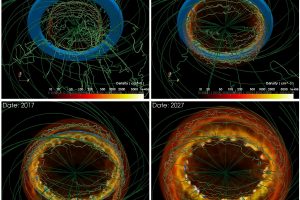31 years of evolution of a supernova remnant. The study: “3D MHD modeling of the expanding remnant of SN 1987A. Role of magnetic field and non-thermal radio emission” of S. Orlando (INAF-OAPA) recently published by A&A

During the 1987 February 23rd night, astronomers observed the explosion of a supernova in the Large Magellanic Cloud, a satellite galaxy of the Milky Way. The exploded star was the blue supergiant Sanduleak (Sk) − 69o202, with a mass of 20 solar masses, and its explosion produced the supernova remnant SN 1987A. From that moment, SN 1987A was observed with several telescopes and satellites operating across almost all the electromagnetic spectrum, from X-rays to radio waves. SN 1987A is still the only existing case that allowed astronomers to observe the formation and evolution of a supernova remnant since the supernova explosion.
Existing studies on SN 1987A published to date focused on several features of the interaction between the expanding blast wave produced by the supernova explosion and the surrounding circumstellar nebula. During its later evolution, in fact, the progenitor star lost most of its mass through an intense stellar wind, which created a circumstellar nebula with an annular morphology along the stellar equatorial plane. Existing studies, however, have ignored the effects due to the local magnetic field, which we know must exist since this is a common feature of stars in our Galaxy and nearby galaxies.
The study: “3D MHD modeling of the expanding remnant of SN 1987A. Role of magnetic field and non-thermal radio emission” of S. Orlando (INAF – Astronomical Observatory of Palermo) describes the first magneto-hydrodynamic model of the evolution of SN 1987A starting from the onset of the blast wave produced by the supernova explosion to date, accounting also for a local magnetic field with an intensity between 0.1 G and 0.001 mG (1 G=1 Gauss, which is the average intensity of the solar magnetic field) at a distance of 0.3 light years from the center of the explosion. This model demonstrates that accounting for the presence of a local magnetic field does not affect the global evolution and the emissivity of the supernova remnant. However, it reduces the possibility that the annular circumstellar cloud is fragmented and destructed by the impact of the expanding blast wave (occurred about 14 years after the supernova explosion). This model also reproduces the light curve (e.g., the emitted energy flux as a function of time) of SN 1987A in X-rays and radio waves. In particular, in order to reproduce the radio light curve, it is necessary to suppress the radio emission arising from the “inverted shock”, which is a blast wave traveling in opposite direction than the primary wave through the stellar material launched by the supernova explosion. If this happens, the radio emission primarily comes from the shocked material in the circumstellar annular nebula. The authors of this study, which has been published by Astronomy & Astrophysics, has also suggested that the suppression of the radio emission of the inverted shock is likely due to a large ionization of the ejected stellar material.
The figure (link) shows four phases of the evolution of SN 1987A described by this model, with also marked the lines of the magnetic field.
by Mario Giuseppe Guarcello ( follow mguarce)
